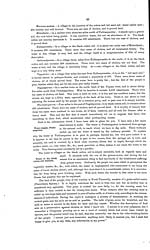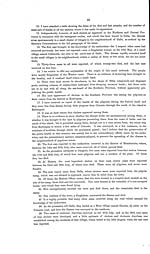Medicine - Disease > Cholera in southern India
(85) Page 61
Download files
Individual page:
Thumbnail gallery: Grid view | List view

61
EXTENSION OF CHOLERA TO CEYLON.
Invasion of Ceylon
in June.
Influence of immi-
gration from Southern
India.
79. Although the sanitary supervision of the Island of Ceylon does not fall
under my jurisdiction, this would seem to be the proper place for noting that
the epidemic, after invading the Tinnevelly District, passed
over to the north shores of the island, which were reached
early in June. A local outbreak had occurred, however, in a village near Point
de Galle so early as the 16th May. It would seem probable that the Galle cholera,
and that on the northern road, must have reached the island by different routes.
The particulars in regard to the development of cholera in Ceylon point, I think,
most clearly to the influence of human intercourse between
the Southern districts of India and Ceylon, the localities
affected being chiefly those on which coolies travel to and fro.
The report of the Principal Medical Officer, Civil Department, Ceylon, is
given below.
From the Principal Civil Medical Officer and Inspector-General of Hospitals in Ceylon, to the
Honourable the Colonial Secretary, Colombo, dated Colombo, 28th September 1870, No. 339.
I have had the honour to receive your letter, No. 253, of the 28th July, transmitting to me
copy of Proceedings of the Madras Government, dated the 9th July, No. 850, on the subject of
cholera in Southern India, and requesting me to report on the origin and progress of the present
outbreak in Ceylon.
2. In explanation of the delay in forwarding this report, I have the honour to state that I
awaited the receipt of the report, called for from the Colonial Surgeon of Jaffna, on the result of his
visit of inspection down the central road from Jaffna to within a few miles of Dambul and on his
return, striking off at Mattakachchee along the road to Mannar, which is frequented by the cooly
immigrants proceeding from the coast to the interior of the island.
3. This report, with its explanatory maps, is now attached, and it affords a fall detail of the
origin and progress of cholera along the central road traversed by coolies on their way to the inte-
rior of the island, and on their return to the coast.
4. It also finally settles the question as to the origin of the disease, which has been recently
raised by the Government Agent for the Northern Province.
5. The letter of the Sanitary Commissioner to the Indian Government, dated 1st July, No. 695,
clearly states "that cholera had been prevailing in the Southern Districts of India for some months
past.
"The disease became general in Tanjore so long back as October and November 1869. It then
extended to Trichinopoly and Madura Districts, and, lastly, to Tinnevelly."
6. It had, moreover, prevailed in Tuticorin, in a minor degree, from 25th April.
7. With these statements, and the facts brought forward by Dr. Ondaatfe, no reasonable doubt
can remain that the cholera which appeared in the north of the island and extended itself along
the central road even as far as Matale and Kandy-spreading, in a few instances, laterally to
Anuradhapura and some neighbouring native villages, as reported by the headmen, locating itself-
in some of the bazaars, where the in-coming coolies were in the habit of resting, and thence regur-
gitating backwards to Davipatam by means of gangs returning to the coast contracting the disease
at the halting places resorted to by the infecting gangs recently arriving-had its origin in the
Southern Districts of India, and not in Ceylon.
8. The first cases reported at Matale were coolies picked up on the road while proceeding
towards the interior of the island on the 19th and 20th June, and the two first cases which occurred
in Kandy were two Canarese, also on their way to the coffee districts, who were found in a state of
collapse in the cooly shed at Mahayawa, at a distance of a mile from the town on the 12th June,
both dates being from nine to sixteen days subsequent to the first cases reported along the central
road.
9. The disease extended in Matale and in Kandy to the inhabitants; but, although very fatal
in its results, it limited itself to a comparatively few cases in both towns, and can no where be said
to have assumed the form of an epidemic.
EXTENSION OF CHOLERA TO CEYLON.
Invasion of Ceylon
in June.
Influence of immi-
gration from Southern
India.
79. Although the sanitary supervision of the Island of Ceylon does not fall
under my jurisdiction, this would seem to be the proper place for noting that
the epidemic, after invading the Tinnevelly District, passed
over to the north shores of the island, which were reached
early in June. A local outbreak had occurred, however, in a village near Point
de Galle so early as the 16th May. It would seem probable that the Galle cholera,
and that on the northern road, must have reached the island by different routes.
The particulars in regard to the development of cholera in Ceylon point, I think,
most clearly to the influence of human intercourse between
the Southern districts of India and Ceylon, the localities
affected being chiefly those on which coolies travel to and fro.
The report of the Principal Medical Officer, Civil Department, Ceylon, is
given below.
From the Principal Civil Medical Officer and Inspector-General of Hospitals in Ceylon, to the
Honourable the Colonial Secretary, Colombo, dated Colombo, 28th September 1870, No. 339.
I have had the honour to receive your letter, No. 253, of the 28th July, transmitting to me
copy of Proceedings of the Madras Government, dated the 9th July, No. 850, on the subject of
cholera in Southern India, and requesting me to report on the origin and progress of the present
outbreak in Ceylon.
2. In explanation of the delay in forwarding this report, I have the honour to state that I
awaited the receipt of the report, called for from the Colonial Surgeon of Jaffna, on the result of his
visit of inspection down the central road from Jaffna to within a few miles of Dambul and on his
return, striking off at Mattakachchee along the road to Mannar, which is frequented by the cooly
immigrants proceeding from the coast to the interior of the island.
3. This report, with its explanatory maps, is now attached, and it affords a fall detail of the
origin and progress of cholera along the central road traversed by coolies on their way to the inte-
rior of the island, and on their return to the coast.
4. It also finally settles the question as to the origin of the disease, which has been recently
raised by the Government Agent for the Northern Province.
5. The letter of the Sanitary Commissioner to the Indian Government, dated 1st July, No. 695,
clearly states "that cholera had been prevailing in the Southern Districts of India for some months
past.
"The disease became general in Tanjore so long back as October and November 1869. It then
extended to Trichinopoly and Madura Districts, and, lastly, to Tinnevelly."
6. It had, moreover, prevailed in Tuticorin, in a minor degree, from 25th April.
7. With these statements, and the facts brought forward by Dr. Ondaatfe, no reasonable doubt
can remain that the cholera which appeared in the north of the island and extended itself along
the central road even as far as Matale and Kandy-spreading, in a few instances, laterally to
Anuradhapura and some neighbouring native villages, as reported by the headmen, locating itself-
in some of the bazaars, where the in-coming coolies were in the habit of resting, and thence regur-
gitating backwards to Davipatam by means of gangs returning to the coast contracting the disease
at the halting places resorted to by the infecting gangs recently arriving-had its origin in the
Southern Districts of India, and not in Ceylon.
8. The first cases reported at Matale were coolies picked up on the road while proceeding
towards the interior of the island on the 19th and 20th June, and the two first cases which occurred
in Kandy were two Canarese, also on their way to the coffee districts, who were found in a state of
collapse in the cooly shed at Mahayawa, at a distance of a mile from the town on the 12th June,
both dates being from nine to sixteen days subsequent to the first cases reported along the central
road.
9. The disease extended in Matale and in Kandy to the inhabitants; but, although very fatal
in its results, it limited itself to a comparatively few cases in both towns, and can no where be said
to have assumed the form of an epidemic.
Set display mode to: Large image | Zoom image | Transcription
Images and transcriptions on this page, including medium image downloads, may be used under the Creative Commons Attribution 4.0 International Licence unless otherwise stated. ![]()
| India Papers > Medicine - Disease > Cholera in southern India > (85) Page 61 |
|---|
| Permanent URL | https://digital.nls.uk/74534330 |
|---|




